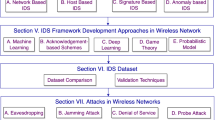Abstract
Black hole attack refers an attack by single or more number of malicious nodes which forcibly captures the route from source to destination by sending reply with largest sequence number and smallest hop count. In this paper, a novel technique using Localized Secure Architecture for MANET (LSAM) routing protocol is proposed to detect and prevent co-operative black hole attack. Security Monitoring Nodes (SMNs) would be activated only if the threshold value is exceeded. If malicious nodes are detected, other SMNs in its proximity area are intimated to isolate the malicious nodes. Network simulator tool is implemented to analyze the network performance of different scenarios with various number of nodes. Packet delivery ratio (PDR), routing overhead, control overhead, packet drop rate, throughput and end-to-end delay (EED) are the factors taken into consideration for performance analysis and it is shown that the proposed protocol is more secured and efficient. PDR is been increased by 27 % in the presence of 40 % misbehaving nodes, while it increases the percentage of overhead on proposed routing protocol from 1 to 4 %. EED is greatly reduced from 0.9 to 0.3 % in LSAM.







Similar content being viewed by others
References
Zhou, L., & Haas, Z. (1999). Securing ad hoc networks. IEEE Network Magazine, 13, 24–30.
Zapata, M., & Asokan, N. (2002). Securing ad hoc routing protocols. In Proceedings of 3rd ACM workshop WiSE, pp. 1–10.
Papadimitratos, P., & Haas, H. (2003). Secure data transmission in mobile ad hoc networks. In Proceedings of ACM workshop WiSE, pp. 41–50.
Yih-Chun, H, & Perrig, A. (2004). A survey of secure wireless ad hoc routing. IEEE Security Privacy, 2, 28–39.
Sanzgiri, K., Dahill, B., Levine, B. N., Shields, C., & Belding-Royer, E. M. (2002). A secure routing protocol for ad hoc network. In Proceedings of 10th IEEE International Conference in Network Protocols (INCP’ 02), IEEE press (pp. 78–87).
Deng, H., & Agarwal, P. (2002). Routing security in wireless ad hoc networks. IEEE Communication Magazine, 40, 70–75.
Perkins, C., Belding-Royer, E., & Das, S. (2003). Ad hoc on-demand distance vector (AODV) routing. IETF RFC, 3561.
Marti, S., Giuli, T. J., Lai, K., & Baker, M. (2000). Mitigating routing misbehaviour in mobile ad hoc networks. In Proceedings of the 6th annual international conference mobile computer networks, pp. 255–265.
Wang, B., Chen, X., & Chang, W. (2014). A light-weight trust-based QoS routing algorithm for ad hoc networks. Pervasive and Mobile Computing, 13, 164–180.
Boppana, R. V., & Su, X. (2011). On the effectiveness of monitoring for intrusion detection in mobile ad hoc networks. IEEE Transactions on Mobile Computing, 10, 1162–1174.
Sánchez-Casado, L., Maciá-Fernández, G., García-Teodoro, P., & Magán-Carrión, R. (2015). A model of data forwarding in MANETs for lightweight detection of malicious packet dropping. Computer Networks, 87, 44–58.
Nadeem, A., & Howarth, M. P. (2014). An intrusion detection & adaptive response mechanism for MANETs. Ad Hoc Networks, 13, 368–380.
Nakayama, H., Kurosama, S., Jamalipour, A., Nemoto, Y., & Kato, N. (2009). A dynamic anomaly detection scheme for AODV-based mobile ad hoc networks. IEEE Transactions on Vehicular Technology, 58, 2471–2481.
Ming-Yang, S. (2011). Prevention of selective black hole attacks on mobile ad hoc networks through intrusion detection systems. Computer Communication, 34, 107–117.
Kurosawa, S., Nakayama, H., Kato, N., Jamalipour, A., & Nemoto, Y. (2007). Detecting blackhole attack on AODV-based mobile ad hoc networks by dynamic learning method. International Journal of Network Security, 5, 338–346.
Latha, T., & Sankaranarayanan, V. (2008). Prevention of co-operative black hole attack in MANET. Journal of Networks, 3, 13–20.
Shakshuki, E. M., Kang, N., & Sheltami, T. (2013). EAACK—A secure intrusion-detection system for MANETs. IEEE Transactions on Industrial Electronics, 60, 1089–1098.
Network Simulator-NS (ver. 2). http://nsnam.isi.edu/nsnam/
Author information
Authors and Affiliations
Corresponding author
Rights and permissions
About this article
Cite this article
Poongodi, T., Karthikeyan, M. Localized Secure Routing Architecture Against Cooperative Black Hole Attack in Mobile Ad Hoc Networks. Wireless Pers Commun 90, 1039–1050 (2016). https://doi.org/10.1007/s11277-016-3318-5
Published:
Issue Date:
DOI: https://doi.org/10.1007/s11277-016-3318-5




